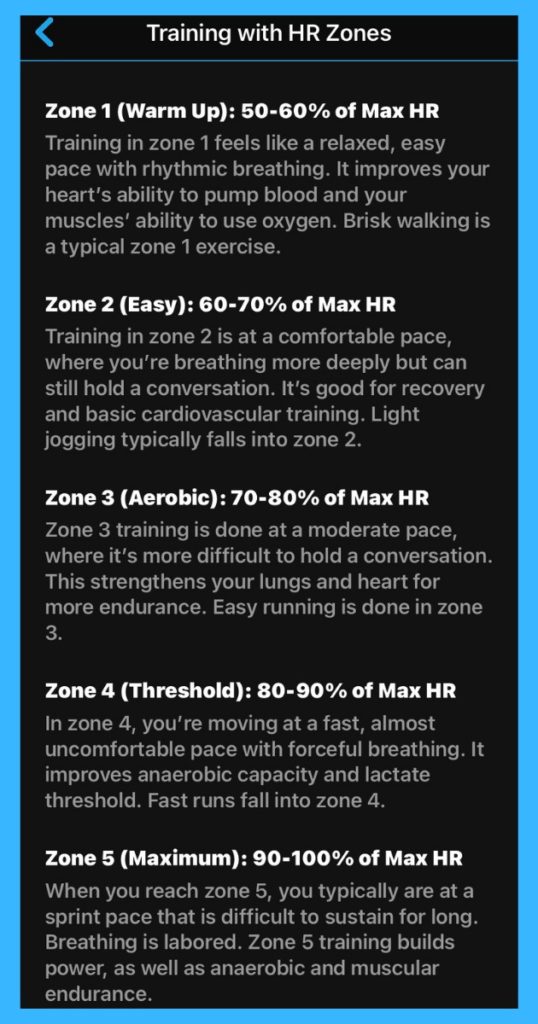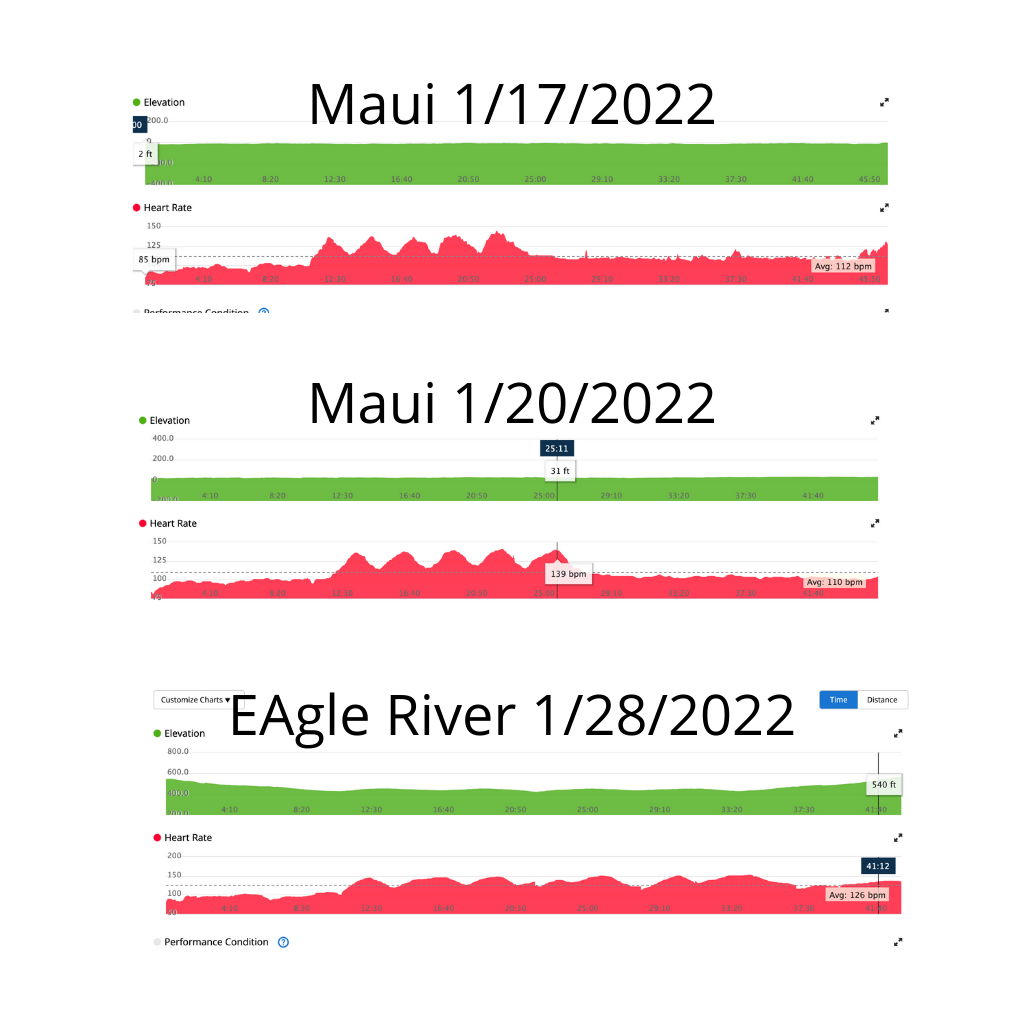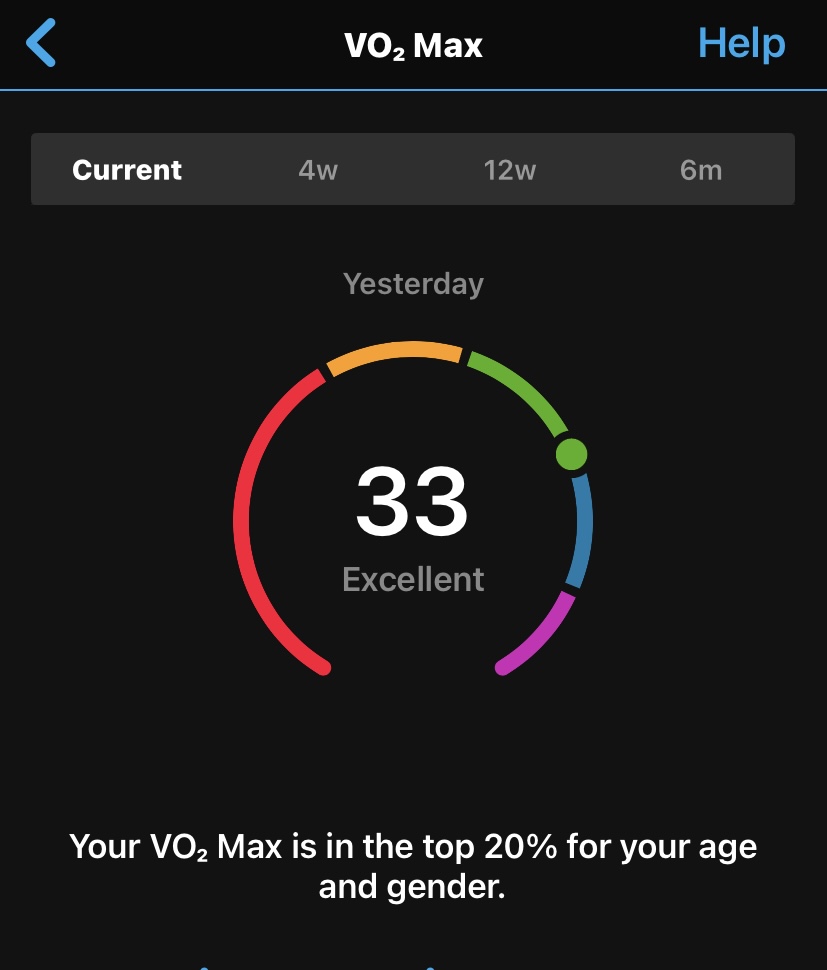In a previous post, I mentioned concerns about my elevated heart rate during my runs and wanted to find out more information about the accuracy of heart rate monitoring via watches. Since then, I have also realized that my Garmin can calculate my heart rate training zones as well.
I have never used heart rate training zones when training for a race or even when building a running base. When out for a run, I typically pace myself based on how I feel instead of monitoring my heart rate. Over my running years, I have heard about heart rate training zones so I am familiar with the concept. With my new Fenix 6s pro watch I now have the capability to monitor heart rate. Plus, my Garmin keeps track of my Time In Training Zones. I thought this would be a useful guide in building my running base. But, I noticed that even when I felt like I was running easy (which is most of my runs right now), according to my Garmin, I was running in a higher percentage of my maximum heart rate than I thought I was.

Maximum heart rate (MHR) is the highest number of beats per minute that your heart can pump blood throughout the body when under maximum stress. There are many ways to calculate MHR, but the most commonly used is simply 220-your age. Keep in mind, all of the formulas are just guidelines and there are many other factors that can affect MHR such as age, genetics, environment, medications, etc… The most accurate way to get a true indication of your maximum heart rate is through a stress test done in a lab by medical professionals.
Using this simple calculation (220-62=158) my MHR is 158 beats per minute.
However, a study in the Journal of the American College of Cardiology used a different formula for people over 60. Yes, that would be me.
208 – (.7 x age) = 208 – (.7x 62) = 164.6 beats per minute. More than 6 beats per minute in comparison to the above formula seems pretty significant.
Heart rate zones are calculated based on a percentage of your MHR. My Garmin uses 5 different zones as explained above in the photo. Each zone can be used depending on what your goal is for a specific workout. For instance, right now my goal is just taking it easy and building my running base. So, I should be in Zone 1 or Zone 2. To calculate my heart rate for these zones, I just simply multiply MHR (I will use the age-adjusted formula) by the percentage of the zone. In my case for zone 2: 164 x .60 = 98.4 beats per minute to 164 x .70 = 115 beats per minute.
So, my heart rate for Zone 2 should be between 98-115 beats per minute. Yet, the graphics from my Garmin tells a different story.

On the 17th, I was running 1 minute/walking 1.5 minutes as can be seen by the spikes in the graphic above, and then I had a long walk after the run. My max heart rate was 145 but during most of the running time, it was in the high 130s. Similarly, on the 20th in Maui, my max heart rate was 141, and again mostly during the running phase, my heart rate was in the high 130s. I had increased my running time to 1.5 minutes with a 1.5-minute walk. Then fast forward to the 28th back on the snow and ice, I ran 2-3 minutes with only 1-minute recovery so obviously, the spikes and recovery time aren’t as obvious. Plus, I was running on pretty flat trails in Maui whereas Eagle River is pretty hilly. And there is a little spike in heart rate during the cool down at the end of the Eagle River run because I have to walk up a double switchback hill to get home.

Most of the time I was in Zone 2 (the warm-up, cool-down, and walking phases). Zones 3, 4, and 5 were when I was actually running. And to be in Zone 5 seems a little scary but I was running hills on the Eagle River route (28th). I was having a little difficulty going up hills, however, I didn’t realize I was working THAT hard.
This information is pretty informative, but my initial question, however, was how accurate is my Garmin heart rate, wrist monitor. I have watched several youtube videos of various comparisons of Garmin watches to chest straps and I have read a few articles but the results are all over the place. Some authors considered monitoring heart rate via watch to be completely inaccurate, whereas others only saw a discrepancy in the cool-down or recovery phases. Almost all of them believe that if you really want to use heart rate zones as a training tool, then a chest strap is the most accurate.
I did my own little test by starting with a resting heart rate and comparing it to my heart rate on my blood pressure machine. It was accurate. Then I ran up and down the stairs several times to get my heart rate up and took the blood pressure again. The heart rate on my Garmin and the one on the blood pressure machine matched. They also matched during a short cool-down phase. I did the same test using my pulse oximeter and got the same results. Very scientific I know. I realize that with longer activities and different environmental conditions, the watch can slide or move on the wrist causing some inaccuracies.
The bottom line is that I don’t think the Garmin is 100% accurate all of the time, but I think it is good enough to use as a guide and for trending purposes. I will continue to monitor the data, and I will start taking it a little easier on those hills. I may just need to really tune into how I am actually feeling. Also, maybe I should find a more flat area to run for a while and see how things go. Even on the flatter boardwalk in Hawaii, my heart rate did go into Zone 4 at times, but I blamed it on the heat. So, I will continue to use my Garmin and the training heart rate zones as a guide to improving my fitness level. I will re-evaluate in a couple of weeks and post an update.
I am continuing to advance on my walk/run program plus I am cross-training on the bike and skiing. The temperatures did warm up to the 40s this past week so conditions were not conducive for skiing. But typical of Alaska, we got a few inches of fresh new snow a couple of days later and Scott and I were able to get out for a bike ride.

Something New
I am learning more and more about my new Garmin. Recently, it let me know that my V02 max was excellent. I have heard the term before, but I do not know what this score even means. Something else to research.

Family
Scott had a birthday. We actually went out to a real restaurant. The apps and dessert were soooo good. I was enjoying dinner so much that I forgot to take a picture. Matt had dropped off a bottle of wine at the restaurant for us and that was pretty special.

Until next time, Happy Running!
Too much information to read. I know the newer garmin and older garmin web sites define the heart rate zones different. Older defines zone 5 as 100-110 max something . Newer defines zone 5 as 90-100% max heartrate. I feel good in zone 3 for easy runs and fund zone 2 way too slow. Strava seems to have the ratio effort higher between heartrate zones 1-5. Zone 2 strava is like zone 3 on my newer Garmin 255 app. I have the forerunner 255 and its pretty accurate but has drifted in accuracy sometimes. Im going to buy the Garmin chest strap electrical monitor and run with that for easy runs. I want more accuracy on my easier runs. When i run tempo or threshold runs i don’t want a chest strap squeezing me or moving lower on my chest from the bouncing, but will settle for the wrist optical watch 255 monitor.
I find that I tend to run in the zone 3 most of the time as well. And like you also, I just feel
like zone 2 is way too slow. Like what’s the point. I would be interested in hearing how the Garmin chest
strap compares in accuracy to the watch. Thanks for the input.